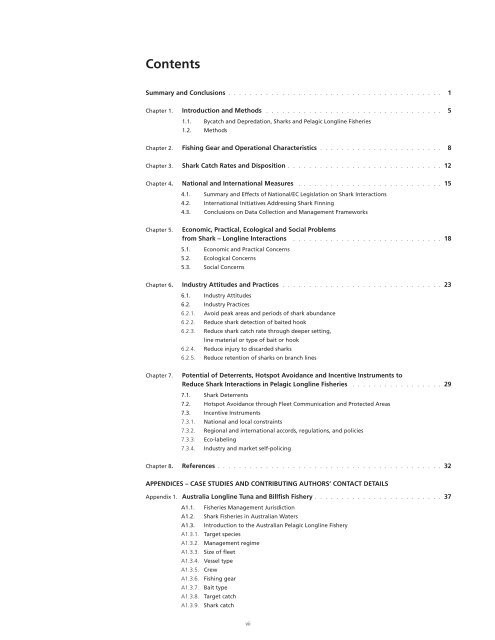Shark Depredation and Unwanted Bycatch in Pelagic Longline
Shark Depredation and Unwanted Bycatch in Pelagic Longline
Shark Depredation and Unwanted Bycatch in Pelagic Longline
Create successful ePaper yourself
Turn your PDF publications into a flip-book with our unique Google optimized e-Paper software.
Contents<br />
Summary <strong>and</strong> Conclusions 1<br />
Chapter 1. Introduction <strong>and</strong> Methods 5<br />
1.1. <strong>Bycatch</strong> <strong>and</strong> <strong>Depredation</strong>, <strong>Shark</strong>s <strong>and</strong> <strong>Pelagic</strong> Longl<strong>in</strong>e Fisheries<br />
1.2. Methods<br />
Chapter 2. Fish<strong>in</strong>g Gear <strong>and</strong> Operational Characteristics 8<br />
Chapter 3. <strong>Shark</strong> Catch Rates <strong>and</strong> Disposition 12<br />
Chapter 4. National <strong>and</strong> International Measures 15<br />
4.1. Summary <strong>and</strong> Effects of National/EC Legislation on <strong>Shark</strong> Interactions<br />
4.2. International Initiatives Address<strong>in</strong>g <strong>Shark</strong> F<strong>in</strong>n<strong>in</strong>g<br />
4.3. Conclusions on Data Collection <strong>and</strong> Management Frameworks<br />
Chapter 5.<br />
Economic, Practical, Ecological <strong>and</strong> Social Problems<br />
from <strong>Shark</strong> – Longl<strong>in</strong>e Interactions 18<br />
5.1. Economic <strong>and</strong> Practical Concerns<br />
5.2. Ecological Concerns<br />
5.3. Social Concerns<br />
Chapter 6. Industry Attitudes <strong>and</strong> Practices 23<br />
6.1. Industry Attitudes<br />
6.2. Industry Practices<br />
6.2.1. Avoid peak areas <strong>and</strong> periods of shark abundance<br />
6.2.2. Reduce shark detection of baited hook<br />
6.2.3. Reduce shark catch rate through deeper sett<strong>in</strong>g,<br />
l<strong>in</strong>e material or type of bait or hook<br />
6.2.4. Reduce <strong>in</strong>jury to discarded sharks<br />
6.2.5. Reduce retention of sharks on branch l<strong>in</strong>es<br />
Chapter 7.<br />
Potential of Deterrents, Hotspot Avoidance <strong>and</strong> Incentive Instruments to<br />
Reduce <strong>Shark</strong> Interactions <strong>in</strong> <strong>Pelagic</strong> Longl<strong>in</strong>e Fisheries 29<br />
7.1. <strong>Shark</strong> Deterrents<br />
7.2. Hotspot Avoidance through Fleet Communication <strong>and</strong> Protected Areas<br />
7.3. Incentive Instruments<br />
7.3.1. National <strong>and</strong> local constra<strong>in</strong>ts<br />
7.3.2. Regional <strong>and</strong> <strong>in</strong>ternational accords, regulations, <strong>and</strong> policies<br />
7.3.3. Eco-label<strong>in</strong>g<br />
7.3.4. Industry <strong>and</strong> market self-polic<strong>in</strong>g<br />
Chapter 8. References 32<br />
Appendices – Case Studies <strong>and</strong> Contribut<strong>in</strong>g Authors’ Contact Details<br />
Appendix 1. Australia Longl<strong>in</strong>e Tuna <strong>and</strong> Billfish Fishery 37<br />
A1.1. Fisheries Management Jurisdiction<br />
A1.2. <strong>Shark</strong> Fisheries <strong>in</strong> Australian Waters<br />
A1.3. Introduction to the Australian <strong>Pelagic</strong> Longl<strong>in</strong>e Fishery<br />
A1.3.1. Target species<br />
A1.3.2. Management regime<br />
A1.3.3. Size of fleet<br />
A1.3.4. Vessel type<br />
A1.3.5. Crew<br />
A1.3.6. Fish<strong>in</strong>g gear<br />
A1.3.7. Bait type<br />
A1.3.8. Target catch<br />
A1.3.9. <strong>Shark</strong> catch<br />
vii












